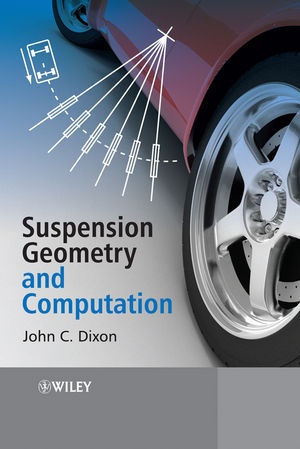Share
Fr. 170.00
Dixon, Jc Dixon, John Dixon, John C. Dixon, John C. (Open University Dixon
Suspension Geometry and Computation
English · Hardback
Shipping usually within 1 to 3 weeks (not available at short notice)
Description
Revealing suspension geometry design methods in unique detail, John Dixon shows how suspension properties such as bump steer, roll steer, bump camber, compliance steer and roll centres are analysed and controlled by the professional engineer. He emphasizes the physical understanding of suspension parameters in three dimensions and methods of their calculation, using examples, programs and discussion of computational problems. The analytical and design approach taken is a combination of qualitative explanation, for physical understanding, with algebraic analysis of linear and non-linear coefficients, and detailed discussion of computer simulations and related programming methods.
* Includes a detailed and comprehensive history of suspension and steering system design, fully illustrated with a wealth of diagrams
* Explains suspension characteristics and suspension geometry coefficients, providing a unique and in-depth understanding of suspension design not found elsewhere.
* Describes how to obtain desired coefficients and the limitations of particular suspension types, with essential information for suspension designers, chassis technicians and anyone else with an interest in suspension characteristics and vehicle dynamics.
* Discusses the use of computers in suspension geometry analysis, with programming techniques and examples of suspension solution, including advanced discussion of three-dimensional computational geometry applied to suspension design.
* Explains in detail the direct and iterative solutions of suspension geometry.
List of contents
Preface.
1 Introduction and History.
1.1 Introduction.
1.2 Early Steering History.
1.3 Leaf-Spring Axles.
1.4 Transverse Leaf Springs.
1.5 Early Independent Fronts.
1.6 Independent Front Suspension.
1.7 Driven Rigid Axles.
1.8 De Dion Rigid Axles.
1.9 Undriven Rigid Axles.
1.10 Independent Rear Driven.
1.11 Independent Rear Undriven.
1.12 Trailing-Twist Axles.
1.13 Some Unusual Suspensions.
References.
2 Road Geometry.
2.1 Introduction.
2.2 The Road.
2.3 Road Curvatures.
2.4 Pitch Gradient and Curvature.
2.5 Road Bank Angle.
2.6 Combined Gradient and Banking.
2.7 Path Analysis.
2.8 Particle-Vehicle Analysis.
2.9 Two-Axle-Vehicle Analysis.
2.10 Road Cross-Sectional Shape.
2.11 Road Torsion.
2.12 Logger Data Analysis.
References.
3 Road Profiles.
3.1 Introduction.
3.2 Isolated Ramps.
3.3 Isolated Bumps.
3.4 Sinusoidal Single Paths.
3.5 Sinusoidal Roads.
3.6 Fixed Waveform.
3.7 Fourier Analysis.
3.8 Road Wavelengths.
3.9 Stochastic Roads.
References.
4 Ride Geometry.
4.1 Introduction.
4.2 Wheel and Tyre Geometry.
4.3 Suspension Bump.
4.4 Ride Positions.
4.5 Pitch.
4.5 Roll.
4.7 Ride Height.
4.8 Time-Domain Ride Analysis.
4.9 Frequency-Domain Ride Analysis.
4.10 Workspace.
5 Vehicle Steering.
5.1 Introduction.
5.2 Turning Geometry - Single Track.
5.3 Ackermann Factor.
5.4 Turning Geometry - Large Vehicles.
5.5 Steering Ratio.
5.6 Steering Systems.
5.7 Wheel Spin Axis.
5.8 Wheel Bottom Point.
5.9 Wheel Steering Axis.
5.10 Caster Angle.
5.11 Camber Angle.
5.12 Kingpin Angle Analysis.
5.13 Kingpin Axis Steered.
5.14 Steer Jacking.
References.
6 Bump and Roll Steer.
6.1 Introduction.
6.2 Wheel Bump Steer.
6.3 Axle Steer Angles.
6.4 Roll Steer and Understeer.
6.5 Axle Linear Bump and Roll Steer.
6.6 Axle Non-Linear Bump and Roll Steer.
6.7 Axle Double-Bump Steer.
6.8 Vehicle Roll Steer.
6.9 Vehicle Heave Steer.
6.10 Vehicle Pitch Steer.
6.11 Static Toe-In and Toe-Out.
6.12 Rigid Axles with Link Location.
6.13 Rigid Axles with Leaf Springs.
6.14 Rigid Axles with Steering.
References.
7 Camber and Scrub.
7.1 Introduction.
7.2 Wheel Inclination and Camber.
7.3 Axle Inclination and Camber.
7.4 Linear Bump and Roll.
7.5 Non-Linear Bump and Roll.
7.6 The Swing Arm.
7.7 Bump Camber Coefficients.
7.8 Roll Camber Coefficients.
7.9 Bump Scrub.
7.10 Double-Bump Scrub.
7.11 Roll Scrub.
7.12 Rigid Axles.
References.
8 Roll Centres.
8.1 Introduction.
8.2 The Swing Arm.
8.3 The Kinematic Roll Centre.
8.4 The Force Roll Centre.
8.5 The Geometric Roll Centre.
8.6 Symmetrical Double Bump.
8.7 Linear Single Bump.
8.8 Asymmetrical Double Bump.
8.9 Roll of a Sy
About the author
Dr John C. Dixon, Eur. Ing., M.A., Ph.D., C.Eng, C.Phys, FIMechE, FRAeS, MinstP, MIET, is a Senior Lecturer at the Open University. He has extensive experience in vehicle dynamics, including shock absorber design and testing for leading racing teams. His previous books include The Shock Absorber Handbook Second Edition, Tires, Suspension and Handling Second Edition and The High Performance Two Stroke Engine.
Summary
Revealing suspension geometry design methods in unique detail, John Dixon shows how suspension properties such as bump steer, roll steer, bump camber, compliance steer and roll centres are analysed and controlled by the professional engineer.
Product details
| Authors | Dixon, Jc Dixon, John Dixon, John C. Dixon, John C. (Open University Dixon |
| Publisher | Wiley, John and Sons Ltd |
| Languages | English |
| Product format | Hardback |
| Released | 23.10.2009 |
| EAN | 9780470510216 |
| ISBN | 978-0-470-51021-6 |
| No. of pages | 440 |
| Subjects |
Natural sciences, medicine, IT, technology
> Technology
> General, dictionaries
Maschinenbau, Fahrzeugtechnik, Automotive Engineering, Mechanical Engineering, Motoren u. Antriebe, Motors & Drivers |
Customer reviews
No reviews have been written for this item yet. Write the first review and be helpful to other users when they decide on a purchase.
Write a review
Thumbs up or thumbs down? Write your own review.

